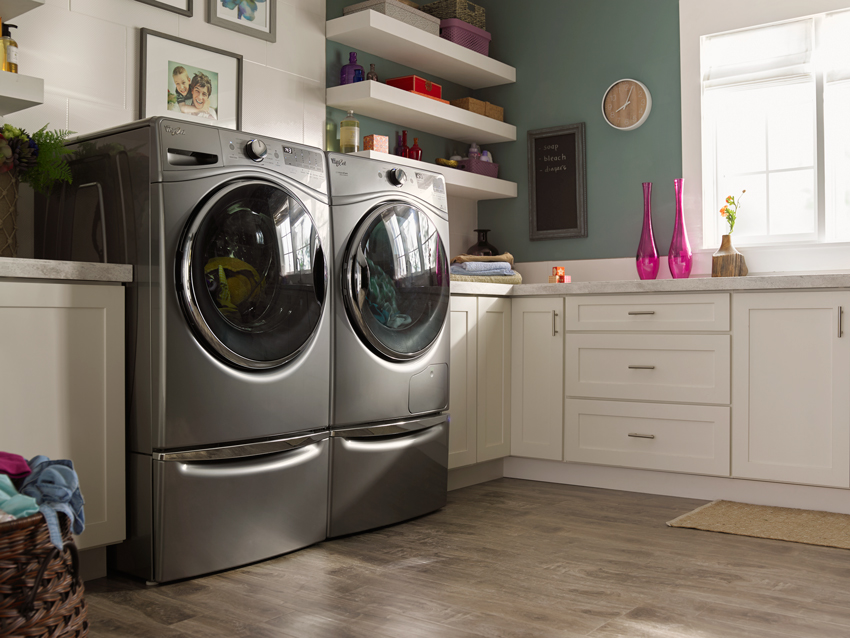Lifelong Housing
Coordinated Laundry Design
Another part of any housing situation that can get used as often as daily is the laundry area. Too many times, though, this is relegated to a place to simply stick appliances without thinking of the accessibility and usability aspects of a truly functional and easy-to-use laundry area. The space required for laundry areas can be controlled, in part, by using front-loading washers and dryers that are fully accessible in the front. Providing ample access into the laundry room or area will allow not only for maneuvering but for other tasks, such as clothes sorting, folding, ironing, etc. Further, actually creating a defined space for the laundry that is designed to be functional in its own right or integrated into another room goes a long way toward the livability of the housing where it is located. It’s also worth noting that the laundry room has become a much more important space in the home, often expanding in size to accomplish many other tasks or integrated into other uses, such as a mudroom, den, or dressing area. The universal design implication here is that the whole room has to be accessible and usable by all.

Photo courtesy Whirlpool Corporation
Well-designed laundry areas can be attractive, functional, accessible, and suitable for people of different ages and abilities.
There are some specific things to keep in mind about the actual washer and dryer appliances, too. Keeping the controls on the front makes it universally easier for anyone to use and operate. Raising these appliances up from the floor will help avoid issues with bending and loading while allowing the opportunity for people to sit rather than stand if needed. Some manufacturers make this easy by providing a base or platform for the washer or dryer to rest on. They may also provide a drawer in the platform to hold dispensers of detergent so lifting heavy laundry detergent bottles is simplified.
In order to provide options for laundry room location, some dryers are now truly ventless, meaning that they don’t need to be located near an outside wall. They operate based on advanced filtering and ventless technology, allowing them to be located just about anywhere. Placing the washer and dryer closer to bedrooms where clothes are stored means that laundry isn’t carried around the house or up and down stairs, making it more comfortable and easier to use for everyone. Overall, laundry areas can function well for all people and provide efficient operation.
Conclusion
The trend of housing design suited to changing lifestyles is clearly receiving a good bit of attention. Young, middle-aged, and older generations of Americans are recognizing the advantages of living in housing and a neighborhood that is attractive, comfortable, and functional for multiple stages of life. Further, universal design principles allow living spaces to be used and enjoyed by many without looking like they are only designed for people with physical disabilities. This is evidenced throughout a building but quite strikingly in the design of kitchen and laundry areas. The variety of standards and resources available allow design professionals to confidently create integrated design solutions that can respond to the differences in the people who will use them, differences that can occur in any one person’s life, or differences over the life of the building. Allowing for this efficiency and flexibility allows people to stay in their homes longer and live a truly more sustainable lifestyle.
End Notes
1Thompson, Derek. “Millennials: The Mobile and the Stuck.” The Atlantic. 24 August 2016. Web. 7 November 2016. www.theatlantic.com/business/archive/2016/08/millennials-the-mobile-and-the-stuck/497255/.
2Lawrence, Ali. “What Millennials Want in a Home.” Millennial Magazine. 30 March 2017. Web. 7 November 2016. millennialmagazine.com/what-millennials-want-in-a-home/.
3“The AARP HomeFit Guide.” AARP Livable Communities. AARP. Web. 7 November 2016. www.aarp.org/livable-communities/info-2014/aarp-home-fit-guide-aging-in-place.html.
4Hollwich, Matthias, Bruce Mau Design. New Aging: Live Smarter Now to Live Better Forever. New York: Penguin, 2016. Print. http://new-aging.com/.
5Chapin, Ross. Pocket Neighborhoods: Creating Small Scale Community in a Large Scale World. Taunton Press. 2011. Web. 7 November 2016. www.pocket-neighborhoods.net.
Peter J. Arsenault, FAIA, NCARB, LEED AP, practices architecture, consults on green and sustainable design, writes on technical topics, and presents nationwide on all of the above. www.linkedin.com/in/pjaarch

|
Whirlpool Corporation is the number-one major appliance manufacturer in the world, with approximately $20 billion in annual sales, 100,000 employees, and 70 manufacturing and technology research centers throughout the world in 2014. The company markets Whirlpool, KitchenAid, Maytag, Consul, Brastemp, Amana, Bauknecht, Jenn-Air, Indesit, and other major brand names in more than 170 countries. Additional information about the company can be found at WhirlpoolCorp.com. |








